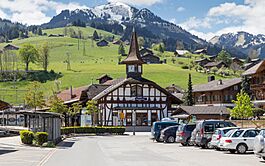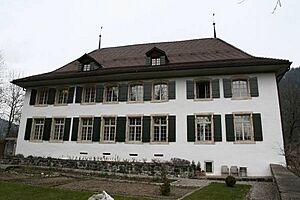Zweisimmen facts for kids
Quick facts for kids
Zweisimmen
|
||
|---|---|---|

The railway station with the Rinderberg in background
|
||
|
||
| Country | Switzerland | |
| Canton | Bern | |
| District | Obersimmental-Saanen | |
| Area | ||
| • Total | 73 km2 (28 sq mi) | |
| Elevation | 947 m (3,107 ft) | |
| Highest elevation | 2,476 m (8,123 ft) | |
| Lowest elevation | 880 m (2,890 ft) | |
| Population
(Dec 2020 )
|
||
| • Total | 3,032 | |
| • Density | 41.53/km2 (107.6/sq mi) | |
| Postal code |
3770
|
|
| Surrounded by | Boltigen, Diemtigen, Saanen, Sankt Stephan | |
| Twin towns | Oberrot (Germany) | |
Zweisimmen is a town in the canton of Bern in Switzerland. It's part of the Obersimmental-Saanen administrative district. This beautiful area is known for its stunning mountains and valleys.
Contents
History of Zweisimmen
Zweisimmen was first mentioned in old records in 1228. It was called Duessimenes back then.
The very first signs of people living here are from the Stone Age. These ancient tools were found at Mannenberg-Riedli. Later, during the time of the Roman Empire, people also lived in an area called Mannried.
During the Middle Ages, an important trade route passed through Zweisimmen. This route went over the Alps to Valais and Lake Geneva. Many small farming villages likely existed here during that time. In the 1200s and 1300s, local noble families built several castles. These included Upper Mannenberg, Lower Mannenberg, Reichenstein-Terenstein, Blankenburg, and Steinegg Castles. They helped protect the roads and collect taxes from traders.
Over time, these villages and castles changed hands. In 1378, the Lord of Düdingen sold the lands to Fribourg after a local uprising. But after the Battle of Sempach in 1386, Bern took control of the Simmen river valley, including Zweisimmen. A Bernese leader was then placed at Blankenburg Castle. Blankenburg village remained an important political center until 1798.
The village's St. Mary's Church was probably built a very long time ago. It was first mentioned in 1228. The church was rebuilt and made bigger several times between the 1200s and 1400s. It has old murals and stained glass from that period. A beautiful carved wooden ceiling was added around 1456. In 1528, Bern adopted the Protestant Reformation. Zweisimmen, like many other areas, was forced to change its religion that same year.
Zweisimmen grew into a local hub for trade and government. In 1644, the yearly fair was moved here. This brought cattle and cheese buyers from Italy and Germany. In the 1750s, a new trade route was built from Thun to Montreux, passing through Zweisimmen. The Simmental road was built from Saanen into the Simmen valley between 1816 and 1845. These new roads brought more trade and, eventually, tourists.
A hotel was built in 1881. When the Spiez-Zweisimmen-Montreux railway was finished in 1905, even more tourists came. The hotel became a spa and resort in 1912, offering winter sports by 1920. The tourism industry faced tough times during the Great Depression and World War II. However, it recovered in the 1950s with new cable cars and ski lifts. Zweisimmen worked with nearby towns like Gstaad and Lenk im Simmental to build large ski resorts and even an airfield.
A regional hospital opened in 1908 and still provides many jobs today. A federal armory used to operate here until 2002. Today, one of the main employers is RUAG Aviation. They work on air defense systems for the Swiss military.
Geography of Zweisimmen
Zweisimmen covers an area of about 73.1 square kilometers (28.2 square miles). A large part of this land, about 55%, is used for farming. Forests cover about 33.7% of the area. Buildings and roads make up about 3.4%. Rivers and lakes cover a small part, about 0.8%. The remaining 7.3% is unproductive land, like rocky areas.
The town is made up of smaller communities. These include Blankenburg, Mannried, and Oeschseite. Blankenburg, with its castle, is the main community. Zweisimmen is located where the Gross and Klein Simme rivers meet.
Coat of Arms
The coat of arms for Zweisimmen shows a black bear on a gold background. The bear is standing on its hind legs and has a red tongue.
Population of Zweisimmen
Zweisimmen has a population of about 2,947 people (as of December 2011). About 9.6% of the people living here are foreign nationals.
Most people in Zweisimmen speak German as their first language (about 94.7%). Albanian is the second most common language, followed by Serbo-Croatian.
In 2008, about 48.8% of the population was male and 51.2% was female. Many people (about 38.4%) were born in Zweisimmen. About 37% were born in the same canton (Bern).
Children and teenagers (ages 0-19) make up about 18.1% of the population. Adults (ages 20-64) make up 58.1%, and seniors (over 64) make up 23.8%.
The population of Zweisimmen has changed over the years:

Important Heritage Sites
Several places in Zweisimmen are considered very important national heritage sites. These include the village church and its rectory (the priest's house). Also, the ruins of both Oberer Mannenberg Castle and Unterer Mannenberg Castle are protected.
Economy and Jobs
In 2011, Zweisimmen had a low unemployment rate of about 1.12%. In 2008, there were 1,558 people working in the town.
Jobs in Zweisimmen fall into three main groups:
- Primary Sector: This includes jobs like farming and forestry. About 255 people worked in this area.
- Secondary Sector: This involves manufacturing and construction. About 262 people worked in these types of jobs.
- Tertiary Sector: This is the largest group, with about 1,041 people. It includes jobs in sales, transportation, hotels, restaurants, healthcare, and education.
Many people who live in Zweisimmen also work there. In 2000, about 70.4% of the workers lived and worked in the town. About 8.3% of workers used public transportation to get to work, and 47.3% used a private car.
Transport
Zweisimmen is a special place for trains! It has a unique system called a gauge changer. This allows train carriages to switch between different track widths. The narrow-gauge Montreux–Lenk im Simmental line meets the standard-gauge BLS railway here. While the carriages can change, the train engines cannot, so they have to be swapped out.
Religion
According to the 2000 census, most people in Zweisimmen (about 79.3%) belonged to the Swiss Reformed Church. About 8.9% were Roman Catholic. There were also smaller numbers of people who belonged to other Christian churches, or were Muslim or Jewish. About 2.32% of the population did not belong to any church.
Climate
Between 1981 and 2010, Zweisimmen had about 139.4 days of rain or snow each year. On average, it received about 1352 millimeters (53.2 inches) of precipitation annually. The wettest month was July, with about 153 millimeters (6 inches) of rain or snow over 13.1 days. June had the most days with precipitation (14.3 days), but slightly less total rain or snow. April was the driest month, with about 88 millimeters (3.5 inches) of precipitation over 11.3 days.
Education
In Zweisimmen, about 56.9% of the population has finished high school (upper secondary education). About 11.9% have gone on to higher education, like a university.
The school system in the Canton of Bern starts with one year of optional Kindergarten. After that, students attend six years of Primary school. Then, they go to three years of lower Secondary school. In secondary school, students are grouped based on their abilities. After lower Secondary, students can continue their education or start an apprenticeship (learning a trade on the job).
During the 2011-2012 school year, 307 students attended classes in Zweisimmen. There were 44 students in kindergarten, 139 in primary school, and 124 in lower secondary school.
Zweisimmen also has a public library called Schul- und Gemeindebibliothek Zweisimmen. In 2008, the library had over 9,805 books and other items. It loaned out 32,361 items that year. The library was open 312 days a year, for about 12 hours per week.
See also
 In Spanish: Zweisimmen para niños
In Spanish: Zweisimmen para niños













